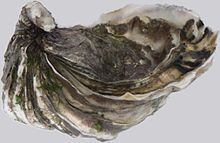
Pacific oyster

The Pacific oyster, Japanese oyster, or Miyagi oyster (Magallana gigas), previously and currently also known as Crassostrea gigas, considered by part of the scientific community to be the proper denomination as an accepted alternative in WoRMS, is an oyster native to the Pacific coast of Asia. It has become an introduced species in North America, Australia, Europe, and New Zealand. The genus Magallana is named for the Portuguese explorer Ferdinand Magellan and its specific epithet gígās is from the Greek for 'giant'. It was previously placed in the genus Crassostrea; from the Latin crass meaning 'thick', ostrea meaning 'oyster' The shell of M. gigas varies widely with the environment where it is attached. Its large, rounded, radial folds are often extremely rough and sharp. The two valves of the shell are slightly different in size and shape, the right valve being moderately concave. Shell colour is variable, usually pale white or off-white. Mature specimens can vary from 80 to 400 mm long. M. gigas is an estuarine species, but can also be found in intertidal and subtidal zones. They prefer to attach to hard or rocky surfaces in shallow or sheltered waters up to 40 m deep, but have been known to attach to muddy or sandy areas when the preferred habitat is scarce. The Pacific oyster can also be found on the shells of other animals. Larvae often settle on the shell of adults, and great masses of oysters can grow together to form oyster reefs. The optimum salinity for Pacific oysters is between 20 and 35 parts per thousand (ppt), and they can tolerate salinities as high as 38 ppt; at this level, however, reproduction is unlikely to occur. The Pacific oyster is also a very temperature tolerant species, as it can withstand a range from -1.8 to 35 °C. The Pacific oyster has separate sexes, but hermaphrodites sometimes do exist. Their sex can be determined by examining the gonads, and it can change from year to year, normally during the winter. In certain environmental conditions, one sex is favoured over the other. Protandry is favoured in areas of high food abundance and protogyny occurs in areas of low food abundance. In habitats with a high food supply, the sex ratio in the adult population tends to favour females, and areas with low food abundances tend to have a larger proportion of male adults. Spawning in the Pacific oyster occurs at 20 °C. This species is very fecund, with females releasing about 50-200 million eggs in regular intervals (with a rate at 5-10 times a minute) in a single spawning. Once released from the gonads, the eggs move through the suprabranchial chambers (gills), are then pushed through the gill ostia into the mantle chamber, and finally are released in the water, forming a small cloud. In males, the sperm is released at the opposite end of the oyster, along with the normal exhalent stream of water. A rise in water temperature is thought to be the main cue in the initiation of spawning, as the onset of higher water temperatures in the summer results in earlier spawning in the Pacific oyster. The larvae of the Pacific oyster are planktotrophic, and are about 70 µm at the prodissoconch 1 stage. The larvae move through the water column via the use of a larval foot to find suitable settlement locations. They can spend several weeks at this phase, which is dependent on water temperature, salinity, and food supply. Over these weeks, larvae can disperse great distances by water currents before they metamorphose and settle as small spat. Similar to other oyster species, once a Pacific oyster larva finds a suitable habitat, it attaches to it permanently using cement secreted from a gland in its foot. After settlement, the larva metamorphoses into a juvenile spat. The growth rate is very rapid in optimum environmental conditions, and market size can be achieved in 18 to 30 months. Unharvested Pacific oysters can live up to 30 years. The genome of M. gigas has been sequenced, revealing an extensive set of genes that enables it to cope with environmental stresses.
